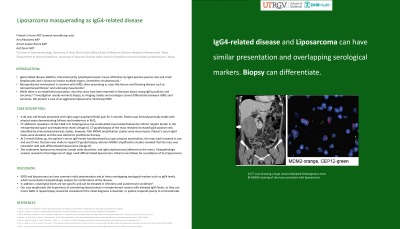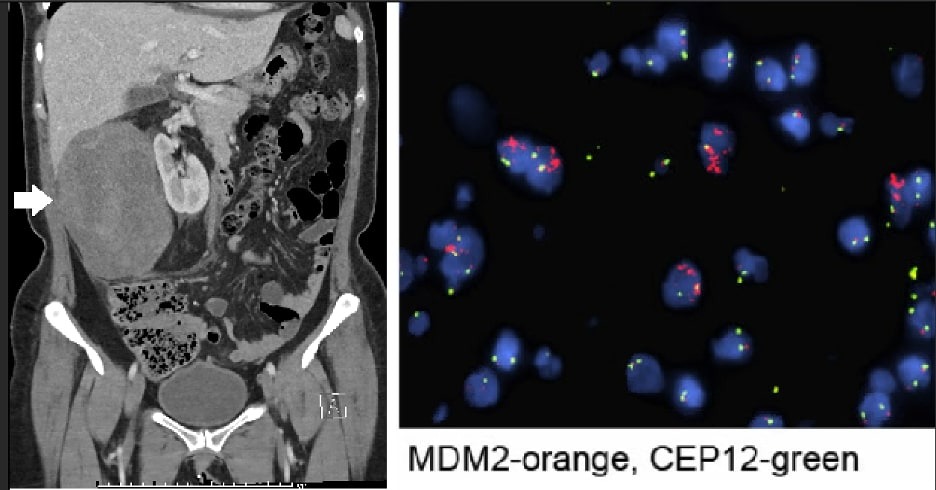Back


Poster Session D - Tuesday Morning
Category: Small Intestine
D0671 - Liposarcoma Masquerading as IgG4-Related Disease
Tuesday, October 25, 2022
10:00 AM – 12:00 PM ET
Location: Crown Ballroom

Has Audio

Prateek S. Harne, MBBS, MD
University of Texas Rio Grande Valley at Doctors Hospital at Renaissance
Edinburg, TX
Presenting Author(s)
Award: Presidential Poster Award
Prateek S. Harne, MBBS, MD, Ans Albustamy, MD, Arturo Suplee Rivera, MD, Asif Zamir, MD, FACG
University of Texas Rio Grande Valley at Doctors Hospital at Renaissance, Edinburg, TX
Introduction: IgG4-related disease (IGRD) is characterized by lymphoplasmacytic tissue infiltration by IgG4-positive plasma cells and small lymphocytes and is known to involve multiple organs, sometimes simultaneously.1 Retroperitoneal involvement is common with IGRD, often presenting as mass-like lesions and fibrosing disease such as retroperitoneal fibrosis2 and sclerosing mesenteritis3. While there is no established association, very few cases have been reported in literature about strong IgG4 positivity and sarcomas.3,4 Investigation usually warrants biopsy, as imaging studies and serologies cannot differentiate between IGRDs and sarcomas. We present a case of an aggressive liposarcoma mimicking IGRD.
Case Description/Methods: A 40-year-old female presented with right upper quadrant (RUQ) pain for 3 months. Patient was hemodynamically stable with physical exam demonstrating fullness and tenderness in RUQ. CT abdomen revealed a 12.9x11.8x8.7 cm heterogenous macro-lobulated mass located below the inferior hepatic border in the retroperitoneal space and hepatorenal recess (Image A). CT guided biopsy of the mass revealed increased IgG4-positive cells identified by immunohistochemical studies, however, FISH MDM2 amplification studies were inconclusive. Patient’s serum IgG4 levels were elevated, and she was started on prednisone therapy. At 2 month follow-up, the patient’s serum IgG4 levels had decreased but upon physical examination, the mass had increased in size and was firmer. Decision was made to repeat CT-guided biopsy, wherein MDM2 amplification studies revealed that the mass was consistent with well-differentiated liposarcoma (Image B). She underwent liposarcoma resection, lymph node dissection, and right nephrectomy (adherent to the mass). Histopathologic analysis revealed a final diagnosis of stage I well-differentiated liposarcoma. Patient now follows for surveillance of her liposarcoma.
Discussion: IGRD and liposarcoma can have common initial presentations and at times overlapping serological markers such as IgG4 levels, which necessitates histopathologic analysis for confirmation of the disease. In addition, raised IgG4 levels are not specific and can be elevated in infections and autoimmune conditions5. Our case emphasizes the importance of considering liposarcomas in retroperitoneal masses with elevated IgG4 levels, as they can mimic IGRD. A repeat biopsy should be considered if the initial diagnosis is doubtful, or patient responds poorly to corticosteroids.

Disclosures:
Prateek S. Harne, MBBS, MD, Ans Albustamy, MD, Arturo Suplee Rivera, MD, Asif Zamir, MD, FACG. D0671 - Liposarcoma Masquerading as IgG4-Related Disease, ACG 2022 Annual Scientific Meeting Abstracts. Charlotte, NC: American College of Gastroenterology.
Prateek S. Harne, MBBS, MD, Ans Albustamy, MD, Arturo Suplee Rivera, MD, Asif Zamir, MD, FACG
University of Texas Rio Grande Valley at Doctors Hospital at Renaissance, Edinburg, TX
Introduction: IgG4-related disease (IGRD) is characterized by lymphoplasmacytic tissue infiltration by IgG4-positive plasma cells and small lymphocytes and is known to involve multiple organs, sometimes simultaneously.1 Retroperitoneal involvement is common with IGRD, often presenting as mass-like lesions and fibrosing disease such as retroperitoneal fibrosis2 and sclerosing mesenteritis3. While there is no established association, very few cases have been reported in literature about strong IgG4 positivity and sarcomas.3,4 Investigation usually warrants biopsy, as imaging studies and serologies cannot differentiate between IGRDs and sarcomas. We present a case of an aggressive liposarcoma mimicking IGRD.
Case Description/Methods: A 40-year-old female presented with right upper quadrant (RUQ) pain for 3 months. Patient was hemodynamically stable with physical exam demonstrating fullness and tenderness in RUQ. CT abdomen revealed a 12.9x11.8x8.7 cm heterogenous macro-lobulated mass located below the inferior hepatic border in the retroperitoneal space and hepatorenal recess (Image A). CT guided biopsy of the mass revealed increased IgG4-positive cells identified by immunohistochemical studies, however, FISH MDM2 amplification studies were inconclusive. Patient’s serum IgG4 levels were elevated, and she was started on prednisone therapy. At 2 month follow-up, the patient’s serum IgG4 levels had decreased but upon physical examination, the mass had increased in size and was firmer. Decision was made to repeat CT-guided biopsy, wherein MDM2 amplification studies revealed that the mass was consistent with well-differentiated liposarcoma (Image B). She underwent liposarcoma resection, lymph node dissection, and right nephrectomy (adherent to the mass). Histopathologic analysis revealed a final diagnosis of stage I well-differentiated liposarcoma. Patient now follows for surveillance of her liposarcoma.
Discussion: IGRD and liposarcoma can have common initial presentations and at times overlapping serological markers such as IgG4 levels, which necessitates histopathologic analysis for confirmation of the disease. In addition, raised IgG4 levels are not specific and can be elevated in infections and autoimmune conditions5. Our case emphasizes the importance of considering liposarcomas in retroperitoneal masses with elevated IgG4 levels, as they can mimic IGRD. A repeat biopsy should be considered if the initial diagnosis is doubtful, or patient responds poorly to corticosteroids.

Figure: Image A) Coronal view of the CT scan showing a macrolobulated heterogenous mass measuring 10.6x10.5x14.1cm, Image B) MDM2 expression of mass using FISH.
Disclosures:
Prateek Harne indicated no relevant financial relationships.
Ans Albustamy indicated no relevant financial relationships.
Arturo Suplee Rivera indicated no relevant financial relationships.
Asif Zamir indicated no relevant financial relationships.
Prateek S. Harne, MBBS, MD, Ans Albustamy, MD, Arturo Suplee Rivera, MD, Asif Zamir, MD, FACG. D0671 - Liposarcoma Masquerading as IgG4-Related Disease, ACG 2022 Annual Scientific Meeting Abstracts. Charlotte, NC: American College of Gastroenterology.


